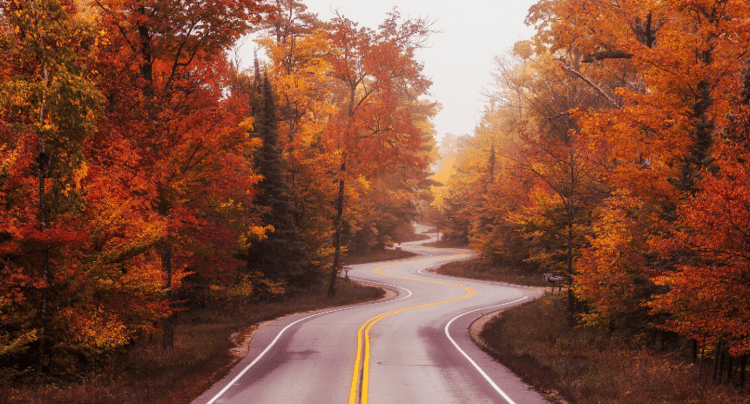
That magnificent season is upon us, when deciduous leaves everywhere show their true colors. Fun fact: Those fall colors are present but hidden in leaves all spring and summer, just obscured by the green of chlorophyll. It isn’t until trees begin preparing for winter that chlorophyll production stops, letting those bright reds, browns, purples, and golds shine through.
If you’re planning a road trip to see this annual exposition, here are some tips to help you prepare for a safe and secure adventure:
Prepare for the Unexpected
Before you leave the house, make sure you have stocked your car for both your adventure and any misadventures along the way:
- Insurance Card: If your insurance card isn’t in your glovebox or wallet already, be sure to have a copy of it with you.
- Emergency Kit: Pack an emergency kit in your car, including a first aid kit, blankets, flashlight, extra batteries, non-perishable snacks, and bottled water. You’re going to want some road snacks anyway, so grab a few extra bags of trail mix and pretzel sticks in case you find yourself in a jam.
- Spare Tire and Tools: Ensure your car has a functioning spare tire, jack, and lug wrench. If you know how to change a tire, it’ll save you from being stranded on the side of the road.
- Weather Watch: Fall weather can be unpredictable, so check the forecast for your route. Be prepared for sudden changes in temperature, rain, or even early snow.
Put Your Safety First
If you have grand visions of an epic road trip worthy of film adaptation after it’s all over, it might be time to scale back your expectations… or at least plan for the safest adventure possible. Better to have fewer epic stories to tell than no stories at all:
- Plan Your Route: Map out your route in advance, considering rest stops and gas stations along the way, and give your itinerary to someone who isn’t traveling with you, so they know where you meant to be along your journey.
- Eliminate Distractions: Keep your focus on the road—after all, this is a road trip to see fall foliage, so you want to be looking out your window anyway. Set up your GPS before you start driving, and use hands-free devices if you need to make calls.
- Rest Well and Avoid Drowsy Driving: Make sure you get plenty of rest before your trip and take breaks every two hours or swap drivers if possible. According to the National Highway Traffic Safety Administration (NHTSA), driver fatigue contributes to approximately 100,000 accidents annually, resulting in an estimated 1,550 deaths and 71,000 injuries. Fatigue-related accidents are particularly common during long road trips, where drivers may push themselves to drive for extended periods without adequate rest.
Review Your Auto Insurance Policy
No one wants to get into a fender bender while on vacation, but these things can happen and are often beyond our control. Before you hit the road, review your current auto insurance policy:
- Coverage Check: Make sure your auto insurance is up to date. Confirm that your policy covers any potential incidents, such as accidents or breakdowns.
- Roadside Assistance: Do you know how to access roadside assistance, if your policy includes it? Verify that you have this option in your plan and note how to connect with this service before you leave. You can save the information in your phone or jot it down to keep in your glove compartment. If your policy doesn’t cover it, consider adding this feature or purchasing a separate plan.
- Rental Car Coverage: If you’re planning to rent a car, check whether your insurance policy covers rental vehicles. If not, consider purchasing additional coverage from your insurance provider or the rental agency.
Consider Additional Coverage
Remember that “beyond your control” bit? If you end up in an accident, there are some things you can do to protect yourself beyond your standard auto insurance policy:
- Uninsured Motorist Coverage: If you don’t already have it, consider adding uninsured motorist coverage to protect yourself in case you’re involved in an accident with an uninsured driver.
- Comprehensive Coverage: Fall means more wildlife on the roads and the potential for fallen branches. Comprehensive coverage can protect you from these types of damages.
- “Toy” Insurance: If you plan to rent a motorcycle, jet ski, e-bike, or another “toy” while on your road trip be sure to check with your agent before you go to make sure your rental is covered. You may need a separate policy to cover these items.
Document Everything
Make sure you have your insurance card, registration, and driver's license easily accessible in case you need to provide them to authorities or your insurance company. Do one last check of your glove compartment to make sure you have all of the necessary documentation.
And if you do end up in an accident, don’t let your itinerary eclipse careful reporting.
You might feel rushed to get it over with so that you can get on with your adventure, but it’s important to thoroughly document the scene by taking photos, noting the location, and gathering information from the other parties involved. As soon as you can, call the claims reporting number provided by your carrier.
